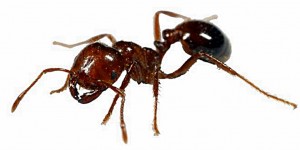Little Fire Ant Infestation Treated in Kaneohe Neighborhood
An infestation of little fire ants (LFA) was reported at a residential neighborhood in Kaneohe and the area was treated on Thursday, Jan. 24, 2019, in a multi-agency effort involving the Hawai‘i Department of Agriculture (HDOA) and the Hawai‘i Ant Lab (HAL). A total of 11 properties covering about two acres were treated, including a 15-meter buffer zone around the infestation area.

Little fire ants are tiny red-orange ants one-sixteenth of an inch long, or about as long as a penny is thick, according to the University of Hawaii College of Tropical Agriculture web site.
On Dec. 13, 2018, a resident on Alokahi Street contacted HDOA to inquire about ants in her home. The resident added that she had traveled to Hawai‘i Island. On Dec. 19, staff from HAL retrieved the ant samples which were identified as LFA on Dec. 20 by an HDOA entomologist. On Dec. 21, HDOA and HAL staff returned to the home and conducted a survey of the exterior of the residence and detected LFA in the patio, carport and along the perimeter of the property. Staff returned on Dec. 24 to survey two surrounding properties which also had LFA.
A larger survey of 12 properties in the area was conducted on Jan. 4 and LFA was found in seven of those properties. On Jan. 9, another survey of two additional properties was conducted and one was found to have LFA. According to the treatment plan developed by HAL researchers, several types of pesticides and bait formulas are applied on a six-week interval for a total of eight treatments. Monitoring of the area will continue for several years.
In June 2014, an LFA infestation was detected in Mililani Mauka which covered six acres. A similar multi-agency response successfully eradicated the infestation and that neighborhood has been free of LFA since February 2015.
“This coordinated treatment and response plan for this infestation has been proven effective in the past and we appreciate the continued assistance of the different agencies and also the cooperation of the residents,” said Denise Albano, chairperson of the Hawai‘i Board of Agriculture. “This incident also reminds everyone to remain vigilant and report any suspected infestation of little fire ants.”
LFA has been found on Hawai‘i Island since 1999 and the population is widespread on this island. Since that initial detection, HAL and HDOA have developed a treatment strategy that has helped to prevent the spread of LFA to other islands.
HDOA and partner agencies, including the Invasive Species Committees on O‘ahu, Kaua‘i, and Maui County and the Coordinating Group on Alien Pest Species (CGAPS) have been asking residents on O‘ahu, Kaua‘i and Maui County to survey their properties for LFA by using a little peanut butter on a chopstick and leave them in several areas for about one hour. Any ants collected should be put in a sealable plastic bag, placed in the freezer for at least 24 hours and dropped off or mailed to any HDOA office. An informational flyer may be downloaded online.
In addition, the Department of Land and Natural (DLNR) Resources has produced a three-minute video, “How to Test for LFA,” which shows the step-by-step procedure for testing for LFA.
How to test for Little Fire Ant from Hawai‘i DLNR on Vimeo.
Originally from South America, LFA is considered among the world’s worst invasive species. LFA are tiny ants, measuring 1/16th inch long, are pale orange in color. LFA move slowly, unlike the Tropical Fire Ant, which is established in Hawai‘i, move quickly, and are much larger with a larger head in proportion to its body. LFA can produce painful stings and large red welts and may cause blindness in pets. They can build up very large colonies on the ground, in trees and other vegetation, and buildings and homes and completely overrun a property.
Suspected invasive species should be reported to the state’s toll-free PEST HOTLINE (808) 643-PEST (7378).














